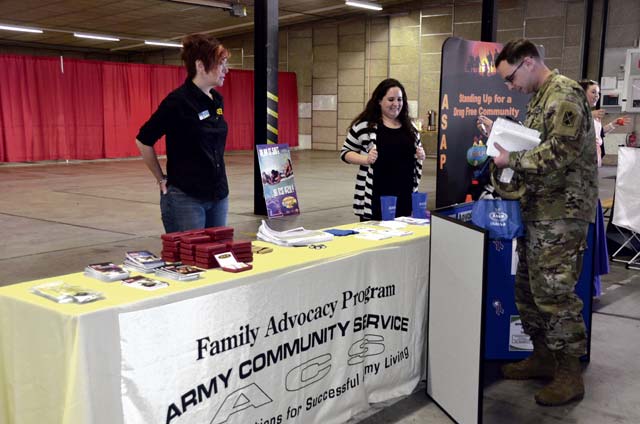
A Soldier receives information from Army Community Service at a Summer Safety Event. Army Community Service is one of the many organizations that is a part of the Installation Prevention Team. — Courtesy Photo
The weekly police blotter reports incidents within the Kaiserslautern Military Community such as traffic violations, alcohol-related offenses and domestic abuse.
However, there are also situations that aren’t common public knowledge — suicide attempts, financial issues, Soldiers going AWOL.
One team spends hours sifting through this data with a sole purpose in mind: to find a way to prevent and mitigate high-risk behavior.
The U.S. Army Garrison Rheinland-Pfalz Installation Prevention Team is made of several key players representing human services agencies within the community. The team’s mission is to monitor incidents and high-risk behaviors and develop and implement prevention plans.
Dr. Camille Owen, Army Substance Abuse Program Risk Reduction coordinator and IPT co-facilitator, explained that data is collected from each agency monthly and presented at a quarterly meeting comprised of subject matter experts and chaired by USAG RP Commander Col. Keith E. Igyarto.
“We look at trends and decide how to mitigate those high-risk areas,” Owen said. “We analyze the data and say, ‘okay — this is what’s going on.’”
Data obtained for each Army unit within the garrison footprint includes number of deaths, accidents, self-harm or suicide attempts, drug offenses, alcohol offenses, AWOL, traffic violations, crimes against persons, crimes against property, crimes against society and other relevant statistics.
Subject matter experts from Casualty Affairs, Safety, Behavioral Health, ASAP, Army Community Service, Directorate of Emergency Services, Criminal Investigation Command and the Office of the Staff Judge Advocate work together to spot correlations between incidents and high-risk behavior, along with consideration for situational factors.
Though programs and services exist and are available for these high-risk behaviors, Owen and IPT Co-facilitator Leslie Sweeney found they were not being used to their full extent. The IPT has worked to overcome this hurdle by bringing the subject matter experts directly to the battalion, brigade and company commanders to address their unit-specific issues and formulate prevention plans.
“If you’re going to affect change, it has to start from the top,” Owen explained.
“We’re really driving it in at the brigade or battalion level, so it’s coming from the top down, which is much more effective than a program manager trying to drive into the units from the bottom up,” agreed Sweeney, ASAP manager and Community Readiness and Resiliency Integrator.
Sweeney, who took a lead role in standing up the IPT in 2016, has worked hard to fine-tune the process to make it effective for the community. She explained that the IPT has led to a revitalization of community efforts to address high-risk behaviors.
“We go forward as a community instead of as individual programs to get within the units and organizations to complete our training and other mitigations to reduce high-risk behavior,” Sweeney said. “IPT brings all of the players together in one place to discuss support of the readiness and resiliency of our entire community.”
The result is that the programs are getting out there and getting into the units like never before with a focus on encouraging Soldiers to make the right choices. When issues arise, Owen stated, “There are programs in place and people who are willing to sit down and listen.”
If you are seeking guidance, training or counseling on a behavior mentioned above, ASAP can help point you in the right direction to get help. Please contact 493-1710.


